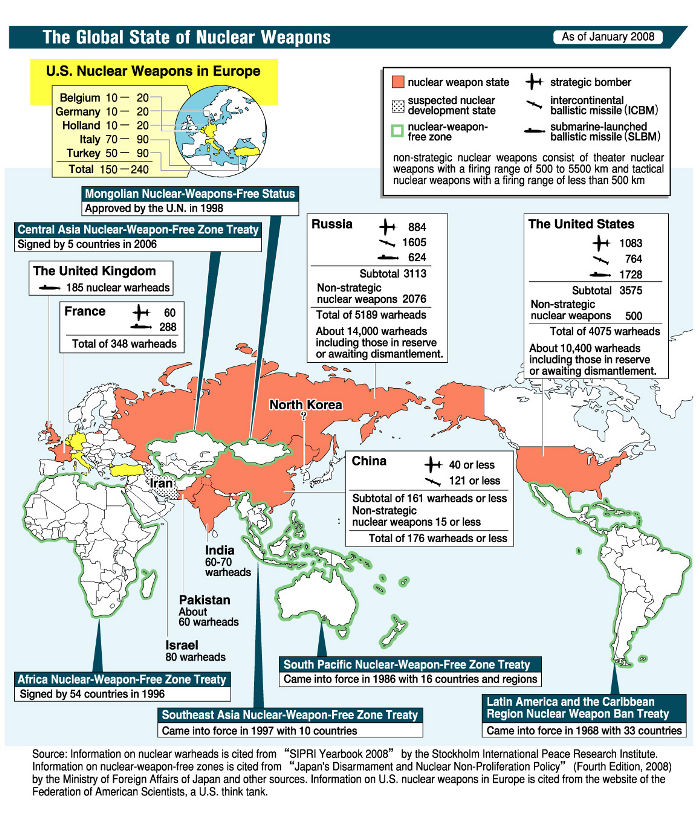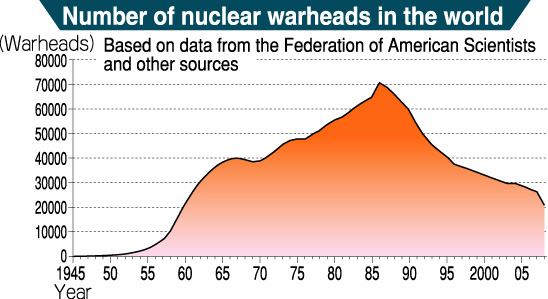Nuclear Weapons Can Be Eliminated: Introduction
Mar. 4, 2009
New global trend toward abolition
by Keisuke Yoshihara, Yumi Kanazaki, and Junichiro Hayashi, Staff Writers
Former top officials who formulated U.S. nuclear policy during the Cold War have called for a world without nuclear weapons, and the leaders of other nuclear nations have expressed their support for this goal. Behind this trend are the threats of nuclear proliferation and nuclear terrorism. While the reasoning may differ from that of the atomic bomb survivors, whose plea is based on their unique experience, the goal of nuclear abolition is the same. In this feature series we will look at the signs of change in the United States, the only nation to wage a nuclear attack, and the current stance of other nations on nuclear weapons.
Growing movement to set deadline for abolition
The movement to set a deadline for the abolition of nuclear weapons is growing. This effort began with the 2020 Vision put forth by Mayors for Peace, an organization whose president is Hiroshima Mayor Tadatoshi Akiba. At the inaugural meeting of the Global Zero forum in Paris last year, a target deadline of 2035 was set.
This new trend differs somewhat from the nuclear abolition movement of the past.
The 2020 Vision was announced in November 2003. Toward that goal, last April Mayors for Peace presented the Hiroshima-Nagasaki Protocol to the international community. It proposes placing legal restrictions via treaties and other means on actions leading to the acquisition of new nuclear weapons or their use through 2015. It also calls for the abolition of systems used for the deployment of nuclear weapons and the destruction of all stockpiles by 2020.
The short-term goal is adoption of the protocol at the 2010 review conference of the Nuclear Non-Proliferation Treaty. Leading up to the conference, Mayors for Peace will ask for approval of the protocol at this fall’s meeting of the United Nations General Assembly and has boosted its efforts to seek the support of governments around the world.
Meanwhile, inspired by the proposal of former Secretary of State George Schulz and other former top U.S. officials, Global Zero, an international movement calling for the elimination of nuclear weapons in stages has been launched as a specific political agenda item. An action plan setting 2035 as the target deadline was announced toward the end of last year.
Instigated by U.S. security and defense research institutes and others, Global Zero has the support of about 100 people, including former U.S. President Jimmy Carter, former Soviet President Mikhail Gorbachev and former Japanese Foreign Minister Yoriko Kawaguchi.
In addition, the International Commission on Nuclear Non-proliferation and Disarmament, which is led by Japan and Australia and held its first meeting last October, is considering including numerical targets for the abolition of nuclear weapons in a report likely to be issued by the end of this year.
10,000 warheads deployed, 5 minutes to midnight on Doomsday Clock
Following the atomic bombings of Hiroshima and Nagasaki, the nuclear arms race escalated, and the number of nuclear warheads grew. There are believed to be more than 25,000 nuclear warheads today, and the world is under the constant threat of the use of nuclear weapons.
By the 1980s the U.S. and Soviet Union alone had 70,000 nuclear warheads between them. The Cold War came to an end in 1989. Negotiations between the U.S. and Soviet Union to reduce their nuclear arsenals began after that, and for a while it seemed that the threat of nuclear war had abated. About 10,000 nuclear warheads remain deployed, however.
The Doomsday Clock published on the cover of The Bulletin of Atomic Scientists depicts the number of “minutes to midnight,” representing the threat of the earth’s destruction by global nuclear war. The clock currently reads 5 minutes to midnight. In 1991 it was set back to 17 minutes to midnight, but in 1998 India and Pakistan conducted nuclear tests. As a result of the terrorist attacks on the U.S. on September 11, 2001, people sensed a new threat from the indiscriminate use of nuclear weapons by terrorists.
North Korea conducted a nuclear test in 2006, and there are suspicions that Iran is developing nuclear weapons. And there are those who argue that Japan should acquire nuclear weapons. Will the Doomsday Clock move even closer to midnight? Or will the nuclear threat be eliminated? The global nuclear situation is approaching a historical turning point.
(Originally published on February 11, 2009)
To comment on this article, please click the link below. Comments will be moderated and posted in a timely fashion. Comments may also appear in the Chugoku Shimbun newspaper.









